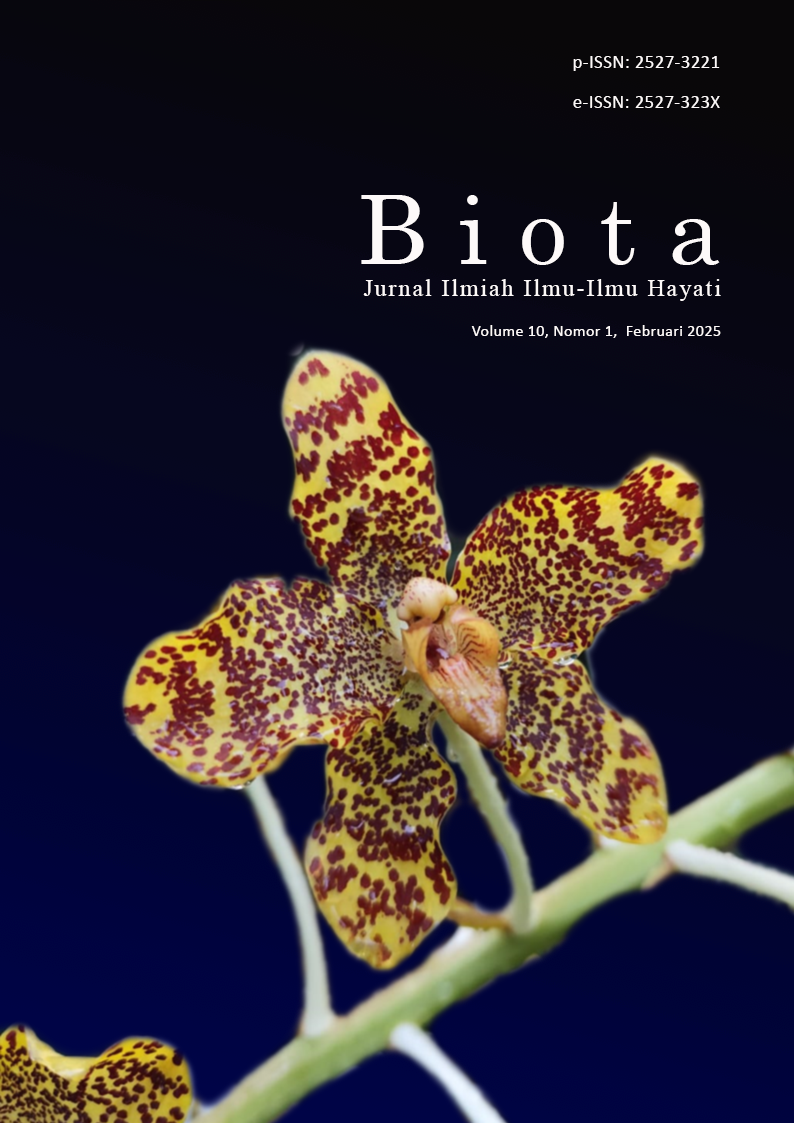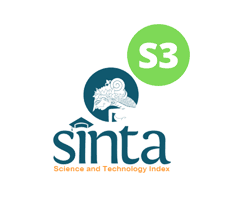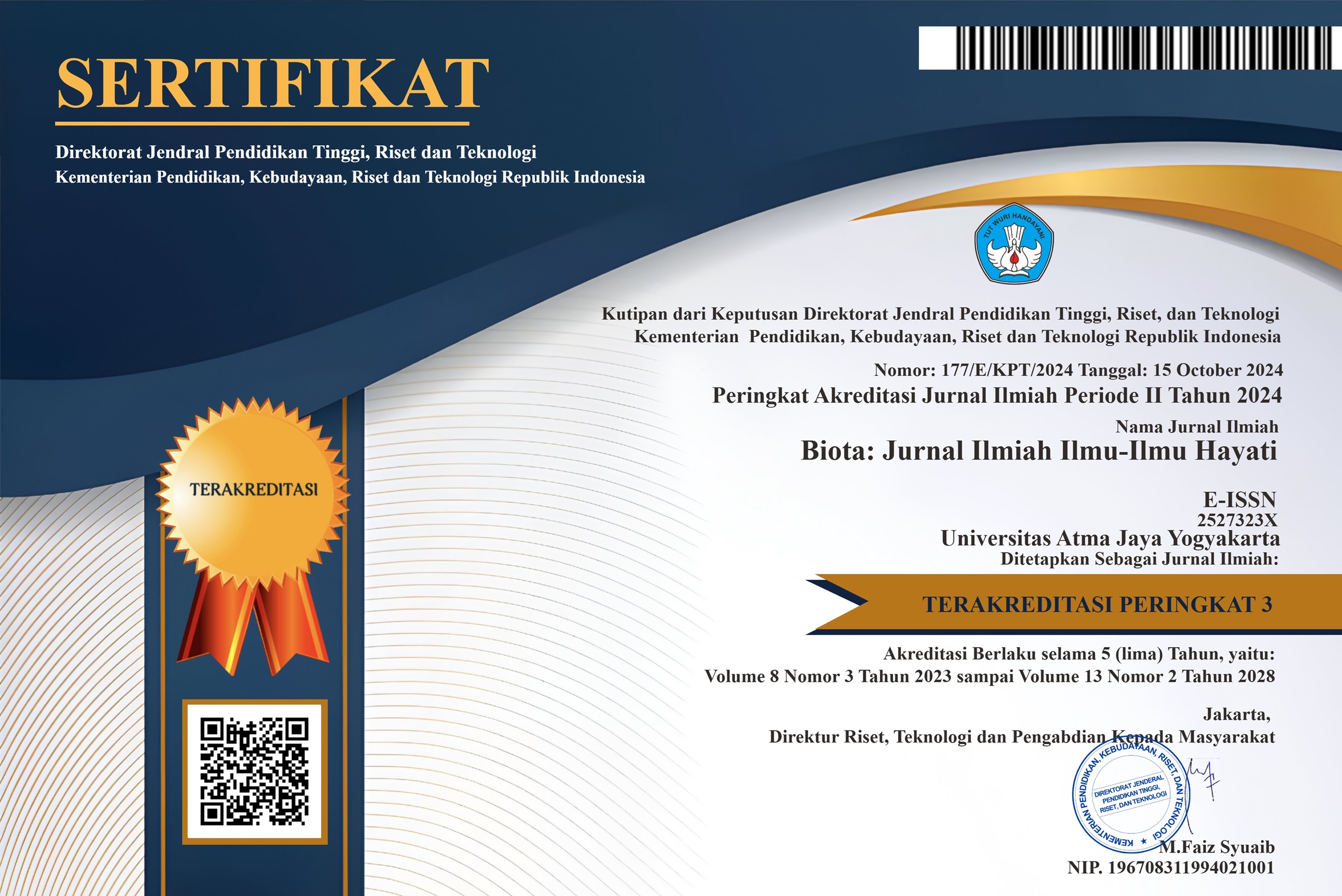Pemetaan Kasus Gigitan Ular di Kabupaten Kulon Progo, Daerah Istimewa Yogyakarta menggunakan Analisis Spasial Statistik
DOI:
https://doi.org/10.24002/biota.v10i1.5331Keywords:
Kulon Progo, pemetaan, analisis pola titik, gigitan ular, epidemiologi spasialAbstract
Kasus gigitan ular merupakan permasalahan kesehatan tropis yang terabaikan. Negara berkembang tropis seperti Indonesia memiliki peluang besar mengalami kasus gigitan ular melebihi angka estimasi. Kasus gigitan ular terjadi di wilayah padat penduduk di mana petani merupakan kelompok paling rentan. Penelitian ini dilakukan untuk mengetahui pola spasial kasus gigitan ular di Kabupaten Kulon Progo pada tahun 2019 – 2020, sebagai langkah pencegahan resiko gigitan ular di masa depan. Data yang diperoleh dari rekam medis RS, penyebaran kuesioner daring, dan wawancara korban dianalisis pola persebaran dari sisi temporal (musim) dan spasial. Dua puluh satu kasus terjadi di Kulon Progo. Korelasi negatif antara kasus gigitan dengan curah hujan ditunjukkan pada tahun 2019 dan korelasi positif pada tahun 2020. Visualisasi peta persebaran, estimasi densitas kernel, dan analisis pola titik menggunakan fungsi G, F, K’s Ripley menjelaskan bahwa sebaran kasus yang terjadi tersebar secara acak di tahun 2019 dan 2020 dengan daerah kasus gigitan terbanyak adalah Samigaluh. Ular Trimeresurus albolabris mendominasi kasus gigitan ular di Kulon Progo yakni sebanyak 48% total kasus gigitan. Maka kesimpulan yang diperoleh adalah kasus gigitan ular di Kulon Progo mengalami peningkatan di musim kering pada tahun 2019 dan di musim hujan pada tahun 2020 serta tersebar secara acak pada kedua tahun.
References
Adiwinata, R., E.J., & Nelwan. 2015. Snakebite in Indonesia. Acta Medica Indonesiana 47(4): 358-365.
Badan Pusat Statistik D.I. Yogyakarta. 2020a. Statistik Daerah Daerah Istimewa Yogyakarta 2020. BPS D.I. Yogyakarta. Yogyakarta.
Badan Pusat Statatistik Kulon Progo. 2017. Luas Lahan Menurut Jenisnya (Hektar), 2016-2017. https://kulonprogokab.bps.go.id/indicator/154/366/1/luas-lahan-menurut-jenisnya.html Diakses pada 11 Desember 2021, jam 23.00.
Badan Pusat Statistik Kulon Progo. 2021. Kabupaten Kulon Progo Dalam Angka 2021. BPS Kabupaten Kulon Progo. Kulon Progo.
Baddeley, A. 2010. Analysing spatial point patterns in R. Version 4.1. Perth: CSIRO and University of Western Australia.
Barnes, C.H., & Knierim, T.K. 2019. Brief insight into the behavior, activity, and interspecific interactions of urban Trimeresurus (Cryptelytrops) albolabris (Reptilia: Squamata: Viperidae) vipers in Bangkok, Thailand. Journal of Threatened Taxa 11(12): 14503–14510.
Belt, P.J., Malhota A., Thorpe, R.S., Warrell, D.A., & Wüster, W. 1997. Symposia of the Zoological Society of London. The Society. London.
Bivand, R.S., E.J. Pebesma, V. Gómez-Rubio. 2013. Applied spatial data analsis with R. Second Edition. Springer. New York.
Brown, N.I. 2012. Consequences of neglect: analysis of the Sub-Saharan African snake antivenom market and the global context. PLoS Neglected Tropical Disease 6(6): e1670.
Chanhome, L., Cox, M.J., Vasaruchapong, T., Chaiyabutr, N., Sitprija, V. 2011. Characterizatio of venomous snakes of Thailand. Asian Biomedicine 5 (3): 311-328
Chanhome, L., Khow, O., Omori-Satoh, T., & Sitprija, V. 2002. Capacity of Thai green pit viper antivenom to neutralize the venoms of Thai Trimeresurus snakes and comparison of biological activities of these venoms. J Nat Toxins 11: 251-259.
Chaves, L.F., Chuang, T., Sasa, M., Gutiérrez, J.M. 2015. Snakebites are associated with poverty, weather fluctuations, and El Nino. Science Advances 1: e1500246.
Chippaux, J.P. 1998. Snake-bites: appraisal of the global situation. Bull World Health Organ 76(5): 515-523.
Chippaux, J.P. 2017. Snakebite envenomation turns again into a neglected tropical disease! Journal of Venomous Animals and Toxins including Tropical Disease 23(38):1-3.
Das, I. 2010. A Field Guide to The Reptiles of South-east Asia. Bloomsburry Publishing Plc. London
Giarno, Dupe, Z.L., & Mustofa, M.A. 2012. Kajian Awal Musim Hujan dan Awal Musim Kemarau di Indonesia. Jurnal Meteorologi dan Geofisika, 13 (1): 3.
Gutiérrez, J.M., D., Williams, H.W., Fan, D.A., & Warrell. 2010. Snakebite envenoming from a global perspective: towards am integrated approach. Toxicon 56(7): 1223-1235.
Gutiérrez, J.M., Warrell D.A., Williams, D.J., Jensen, S., Brown, N., Calvete, J.J., & Harrison, R.A. 2013. The need for full integration of snakebite envenoming within a global strategy to combat the neglected tropical disease: the way forward. PLoS Neglected Tropical Disease 7: e2162.
Hansson, E., Sasa, M., Mattison, K., Robles, A., Gutiérrez, J.M. 2013. Using geographical information systems to identify populations in need of improved accessibility to antivenom treatment for snakebite envenoming in Costa Rica. PLoS Negl Trop Dis7(1):e2009.doi:10.1371/journal.pntd.0002009.
Kasturiratne, A., A.R., Wickremasinghe, N. de Silva, N.K., Gunawardena, A., Pathmeswaran, R. Premaratna, L., Savioli, D.G., Lalloo, H.J. de Silva. 2008. The global burden of snakebites: a literature analysis and modelling based on regional estimates of envenoming and deaths. PLoS Med 5(11): e281.
Lillywhite, H.B. 2014. How Snakes Work: Structure, Function, and Behavior of the World’s Snakes. First Edition. Oxford University Press. New York.
Mohapatra, B., D.A. Warrell, W. Suraweera, P., Bhatia, N., Dhingra, R.M., Jotkar, P.S., Rodriguez, K. Mishra, R., & Whitaker, P. Jha. 2011. Snakebites mortality in India: a nationally representative mortality survey. PLoS Neglected Tropical Disease 5(4): e1018.
Ngowi H.A., Kassuku A.A., Carabin H., Mlangwa J.E., Mlozi M., Mbilinyi B.P.,
Willingham A.L. 2010. Spatial clustering of porcine cysticercosis in Mbulu district, northern Tanzania. PLoS Neglected Tropical Disease 4:e652.
O’Shea, M. 2011. Venomous snakes of the world. Princeton University Press. Princeton.
O’Sullivan, D., & Unwin, D. 2010. Geographic information analysis. John Wiley & Sons. Hoboken.
Orlov, N., Ananjeva, N., Barabanov, A., Ryabov, S., & Khalikov, R. 2002. Diversity of vipers (Azemiopinae, Crotalinae) in East, Southeast, and South Asia: Annotated checklist and natural history data (Reptilia: Squamata: Serpentes: Viperidae). Faunistische Abhandlungen 23 (2): 206-207.
Pranita, E. 2019. Setelah 10 Bulan, El Nino Lemah 2018/2019 Akhirnya Berakhir. https://sains.kompas.com/read/2019/08/16/190700323/setelah-10-bulan-el-nino-lemah-2018-2019-akhirnya-berakhir Diakses pada 15 Desember 2021, jam 19.30.
Rahman, R., M.A. Faiz, S. Selim, B. Rahman, A. Basher, A. Jones, C.d’Este, M. Hossain, Z. Islam, H. Ahmed. 2010. Annual incidence of snake bite in rural Bangladesh. PLoS Neglected Tropical Disease 4(10): e860.
Rifaie, F., T., Maharani, Hamidy, A. 2017. Where did Venomous Snake Strike? A Spatial Statistical Analysis of Snakebite Cases in Bondowoso Regency, Indonesia. HAYATI Journal of Biosciences 24(3): 142-148
Sasa, M., Vazquez, S. 2003. Snakebite envenomation in Costa Rica: a revision of incidence in the decade 1990-2000. Toxicon. 41(1): 19-22.
The Reptile Database. 2024. Coelognathus flavolineatus. https://reptile-database.reptarium.cz/species?genus=Coelognathus&species=flavolineatus. Diakses 1 Juni 2024, jam 16.24.
The Reptile Database. 2024. Craspedocephalus puniceus. https://reptile-database.reptarium.cz/species?genus=Craspedocephalus&species=puniceus&search_param=%28%29. Diakses 1 Juni 2024, jam 16.24.
The Reptile Database. Trimeresurus albolabris. https://reptile-database.reptarium.cz/species?genus=Trimeresurus&species=albolabris&search_param=%28%28genus%3D%27Trimeresurus%27%29%29. Diakses 1 Juni 2024, jam 16.24.
Warrel, D.A. 2010a. Snake bite. The Lancet, 375(9708): 77-88.
Warrell, D.A. 2010b. Guidelines for the management of snake-bites. WHO Regional Office for South-East Asia. New Delhi.
World Health Organization. 2002. Communicable Diseases 2002: Global Defence against the Infectious Disease Threat. World Health Organization. Geneva.
Wright, S.J., Calderon, O. 2006. Seasonal, El Nino and longer term changes i flower and seed production in a moist tropical forest. Ecology Letters 9 (1): 35-44.
Wright, S.J., Carrasco, C., Calderon, O., & Paton, S. 1999. The El Nino southern oscillation, variable fruit production, and famine in a tropical forest. Ecology 80: 1632-1647.
Zhang, J., C. He, Y. Zhou, S. Zhu, G., & Shuai. 2014. Prior-knowledge-based spectral mixture analysis for impervious surface mapping. International Journal of Applied Earth Observation Geoinformation 28: 201-210.
Downloads
Published
How to Cite
Issue
Section
License
Copyright (c) 2025 Donan Satria Yudha, Ananta Widi Raihan, Muhamad Yusril Al Faqih

This work is licensed under a Creative Commons Attribution-NonCommercial 4.0 International License.
Authors who publish with Biota : Jurnal Ilmiah Ilmu-Ilmu Hayati agree to the following terms:
- Authors retain copyright and grant the Biota : Jurnal Ilmiah Ilmu-Ilmu Hayati right of first publication. Licensed under a Creative Commons Attribution-NonCommercial 4.0 International License that allows others to share the work with an acknowledgment of the work's authorship and initial publication in this journal.
- Authors are able to enter into separate, additional contractual arrangements for the non-exclusive distribution of the journal's published version of the work (e.g., post it to an institutional repository or publish it in a book), with an acknowledgment of its initial publication in Biota : Jurnal Ilmiah Ilmu-Ilmu Hayati, and as long as Author is not used for commercial purposes.













